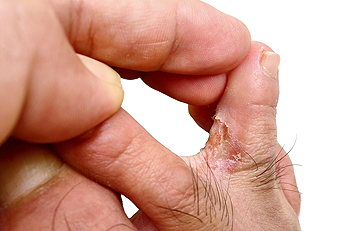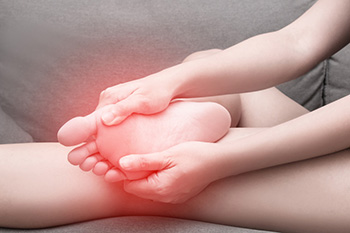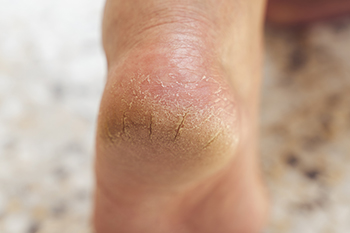
Athlete's foot is a contagious skin infection caused by a fungus that thrives in warm, moist environments. It typically affects the skin between the toes and on the soles of the feet. Risk factors include walking barefoot in communal areas, excessive sweating, and wearing damp socks or tight shoes. Common symptoms are itching, burning, peeling, and cracked skin. If untreated, it can spread or lead to more serious infections. A podiatrist can diagnose the condition, recommend antifungal treatments, and provide advice on proper foot hygiene. If you have symptoms of athlete’s foot, it is suggested that you consult a podiatrist who can accurately diagnose and treat this condition, which may include prescribed medication.
Athlete’s Foot
Athlete’s foot is often an uncomfortable condition to experience. Thankfully, podiatrists specialize in treating athlete’s foot and offer the best treatment options. If you have any questions about athlete’s foot, consult with Thomas Vail, DPM from Step Alive Foot & Ankle Center. Our doctor will assess your condition and provide you with quality treatment.
What Is Athlete’s Foot?
Tinea pedis, more commonly known as athlete’s foot, is a non-serious and common fungal infection of the foot. Athlete’s foot is contagious and can be contracted by touching someone who has it or infected surfaces. The most common places contaminated by it are public showers, locker rooms, and swimming pools. Once contracted, it grows on feet that are left inside moist, dark, and warm shoes and socks.
Prevention
The most effective ways to prevent athlete’s foot include:
- Thoroughly washing and drying feet
- Avoid going barefoot in locker rooms and public showers
- Using shower shoes in public showers
- Wearing socks that allow the feet to breathe
- Changing socks and shoes frequently if you sweat a lot
Symptoms
Athlete’s foot initially occurs as a rash between the toes. However, if left undiagnosed, it can spread to the sides and bottom of the feet, toenails, and if touched by hand, the hands themselves. Symptoms include:
- Redness
- Burning
- Itching
- Scaly and peeling skin
Diagnosis and Treatment
Diagnosis is quick and easy. Skin samples will be taken and either viewed under a microscope or sent to a lab for testing. Sometimes, a podiatrist can diagnose it based on simply looking at it. Once confirmed, treatment options include oral and topical antifungal medications.
If you have any questions, please feel free to contact our office located in Findlay, OH . We offer the newest diagnostic and treatment technologies for all your foot care needs.

Wearing shoes that do not fit properly is a leading cause of foot pain as well as long-term complications. Tight or loose footwear can lead to corns, calluses, and even foot deformities, such as bunions or hammertoes. Over time, discomfort may limit mobility and discourage regular activity. Ill-fitting shoes can also worsen conditions like peripheral neuropathy by adding pressure and irritation to sensitive areas. A podiatrist can examine your foot shape, assess any damage, and recommend properly fitting shoes or custom orthotics to relieve pain and prevent further issues. If you have developed foot pain from wearing the wrong type of shoes, it is suggested that you schedule a visit with a podiatrist who can treat various foot conditions and offer the right guidance for your specific needs.
Foot Pain
Foot pain can be extremely painful and debilitating. If you have a foot pain, consult with Thomas Vail, DPM from Step Alive Foot & Ankle Center. Our doctor will assess your condition and provide you with quality foot and ankle treatment.
Causes
Foot pain is a very broad condition that could be caused by one or more ailments. The most common include:
- Bunions
- Hammertoes
- Plantar Fasciitis
- Bone Spurs
- Corns
- Tarsal Tunnel Syndrome
- Ingrown Toenails
- Arthritis (such as Gout, Rheumatoid, and Osteoarthritis)
- Flat Feet
- Injury (from stress fractures, broken toe, foot, ankle, Achilles tendon ruptures, and sprains)
- And more
Diagnosis
To figure out the cause of foot pain, podiatrists utilize several different methods. This can range from simple visual inspections and sensation tests to X-rays and MRI scans. Prior medical history, family medical history, and any recent physical traumatic events will all be taken into consideration for a proper diagnosis.
Treatment
Treatment depends upon the cause of the foot pain. Whether it is resting, staying off the foot, or having surgery; podiatrists have a number of treatment options available for foot pain.
If you have any questions, please feel free to contact our office located in Findlay, OH . We offer the newest diagnostic and treatment technologies for all your foot care needs.

Cracked heels occur when the skin on the bottom of the feet becomes excessively dry and thick, leading to painful splits or fissures. Dry skin can be caused by prolonged standing, wearing open-back footwear, cold weather, or lack of moisture. Over time, the dryness may worsen and the skin loses elasticity, eventually leading to deep cracks that can cause discomfort, bleeding, or infection. Symptoms include rough patches, flaking, redness, and pain while walking. A podiatrist can assess the severity, remove thickened skin safely, recommend moisturizing treatments, and address any complications. If you are experiencing discomfort from having cracked heels, it is suggested that you schedule a visit with a podiatrist to restore smooth, healthy skin, and prevent further damage.
If the skin on your feet starts to crack, you may want to see a podiatrist to find treatment. If you have any concerns, contact Thomas Vail, DPM from Step Alive Foot & Ankle Center. Our doctor can provide the care you need to keep you pain-free and on your feet.
Cracked Heels
It is important to moisturize your cracked heels in order to prevent pain, bleeding, and infection. The reason cracked heels form is because the skin on the foot is too dry to support the immense pressure placed on them. When the foot expands, the dry skin on the foot begins to split.
Ways to Help Heal Them
- Invest in a good foot cream
- Try Using Petroleum Jelly
- Ease up on Soaps
- Drink Plenty of Water
Ways to Prevent Cracked Heels
- Moisturize After Showering
- Skip a Shower
- Keep Shower Water Lukewarm
- Don’t Scrub Your Feet
If you are unsure how to proceed in treating cracked heels, seek guidance from a podiatrist. Your doctor will help you with any questions or information you may need.
If you have any questions, please feel free to contact our office located in Findlay, OH . We offer the newest diagnostic and treatment technologies for all your foot care needs.

